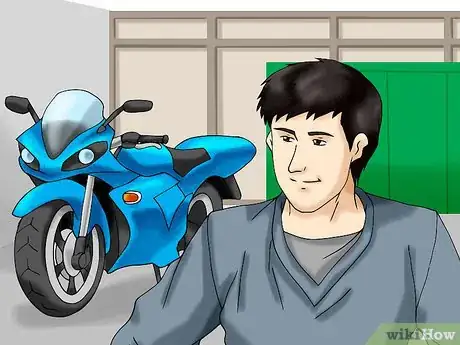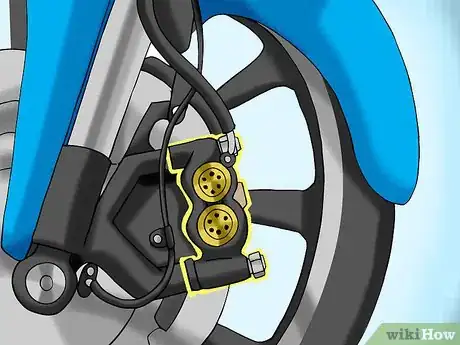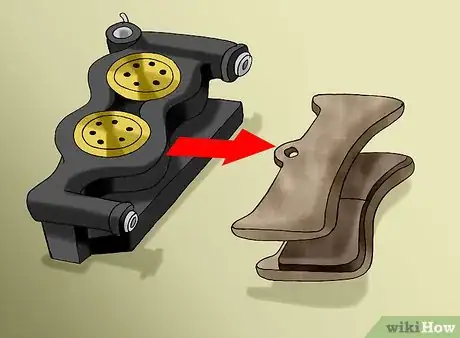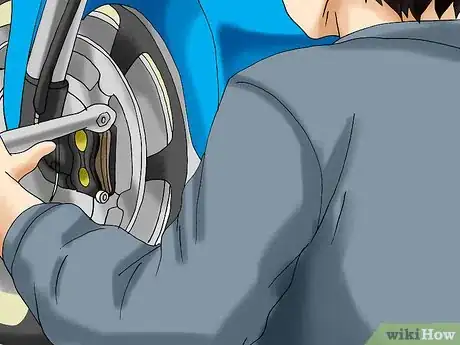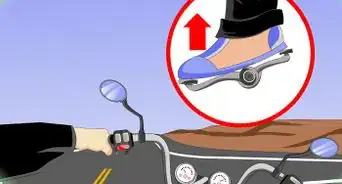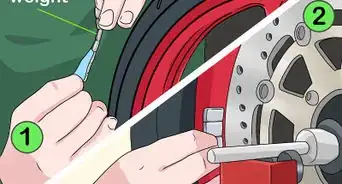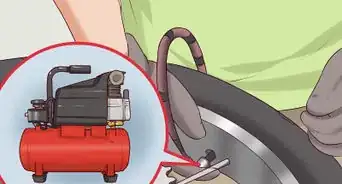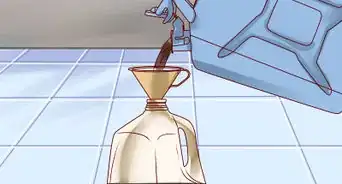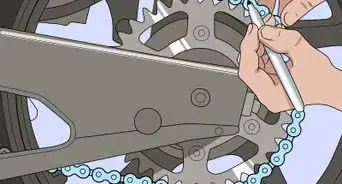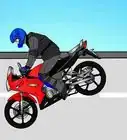wikiHow is a “wiki,” similar to Wikipedia, which means that many of our articles are co-written by multiple authors. To create this article, 13 people, some anonymous, worked to edit and improve it over time.
There are 7 references cited in this article, which can be found at the bottom of the page.
This article has been viewed 49,429 times.
Learn more...
If your motorcycle has disc brakes, you will need to change the pads once in a while. It is extremely important that you know what you are doing before you attempt this. Although not the most difficult task in motorcycle maintenance, a careless mistake could cost you your life if the brakes fail. If you are not confident you are following the instructions correctly at any point, stop and take the motorcycle to a mechanic.
Steps
-
1Do not attempt this without previous experience. Brakes are one of the most important safety features on your motorcycle. If you are not familiar with motorcycle parts, take your vehicle to a mechanic certified to work on your make and model. A mistake in a home repair could be fatal.[1]
- Caution! — Due to the vast number of makes and models of motorcycles, it is not possible to give instructions that match every case. This article should supplement your motorcycle owner's manual, not replace it.
-
2Remove the brake caliper mechanism. There are usually two bolts holding the brake caliper onto the bike, requiring a size 8, 10, or 12mm socket wrench. The exact setup varies with the make and model.[2]
- If you're using a basic Allen key wrench instead of a socket, you might want to "crack" (loosen slightly) the other two bolts on the caliper, holding in the brake pads. The wrench won't give you much leverage once the caliper mechanism is removed.
Advertisement -
3Remove the brake pads. Most motorcycles have two bolts holding in the brake pads. These typically have an Allen key head. They are much easier to remove and install using an Allen key socket for more leverage. Once the bolts are loosened, the pads will either fall out or can be wiggled out by hand.[3]
- Some manufacturers use cotter keys or retaining pins to hold in the brake pads as well. Make note of these if present.
- On most models, one of the two pads is shaped slightly differently to fit into the caliper next to the front forks. Look carefully, since the replacements will need to go in the exact shape and position.
-
4Push the caliper pistons back out of the way. The pistons should be easily visible behind where the brake pads once were. Before you can install your new brake pads, you must push these pistons as far back into the caliper cylinder as possible. This will keep the pistons out of the way while you install the new pads, and insure that the new pads are flush with the caliper sides. On bikes 250cc or less, you may be able to push the pistons back by hand. For larger bikes, press them back with reverse pliers or a large blade flathead screwdriver.[4]
- If you accidentally open the master cylinder cap or otherwise introduce air into the brake lines, you will need to bleed the brake line (refer to your owner's manual). In most cases this is not necessary.
-
5Install the new pads. Make sure the new pads are the exact shape and size of the old ones. If the two pads are different sizes (which is common), make sure you know which pad goes into which side of the caliper. Insert the pad, aligning the bolt holes carefully with the holes in the caliper. Insert the bolts and hand tighten for now.[5]
- On most motorcycles it is not possible to install the pads backwards as they will only fit into the calipers one way. It's still best to pay attention to the position of the old pads, just in case.
-
6Reinstall the brake caliper mechanism. Assuming the pads are flush with the caliper sides and aligned with the bolt holes, it's time to secure the caliper mechanism back onto the front brake rotor. Align the bolt holes on the caliper and the bracket or front forks (depending on model). Insert the bolts and tighten with a torque wrench. It is very important' to tighten to the exact specifications mentioned in your owner's manual. The wrong torque can cause the bolts to snap off or come loose on the road.[6]
-
7Fully tighten the brake pad bolts. Remember, your brake pad bolts were only hand tightened. Now that the caliper is secure, you have the leverage to finish tightening the Allen key bolts easily.
- Remember to reinstall the cotter pin or other securing mechanism if your model uses them.
-
8Pump the brake lever before riding. Pushing the caliper pistons back caused the brake fluid to flow back into the master cylinder reservoir. The first squeeze of the lever will get all the way to the grip without resistance, as if there is no fluid. Pump several times until you feel the correct amount of resistance on the lever, and you can feel the brakes putting resistance on the front rotor. As a final test, spin the front tire by hand and confirm that you can stop it by squeezing the brake lever.[7]
- Never forget this step after a brake change. The brakes will not work until your push the brake fluid back down.
- Do not ride your motorcycle if the lever feels looser than normal. Take it to a licensed mechanic.
-
9Go easy on your brakes for the next 350 miles. New brake pads need an adjustment period to work properly. For the next 250–350 miles, ride at slower speeds and allow plenty of extra stopping distance. This allows you to apply the brakes gradually, preventing brake failure or damage to the pads or rotor.
Community Q&A
-
QuestionWhat do I do with the brake line and the fluid?
 Community AnswerI assume the above pictures are for illustration only. When doing this you can leave the brake lines attached. You don't need to disassemble the lines or mess with the fluid to change the brake pads. Check your brake fluid levels afterwards, but they should be fuller, as the new pads will be thicker than the worn ones.
Community AnswerI assume the above pictures are for illustration only. When doing this you can leave the brake lines attached. You don't need to disassemble the lines or mess with the fluid to change the brake pads. Check your brake fluid levels afterwards, but they should be fuller, as the new pads will be thicker than the worn ones.
Things You'll Need
- Your motorcycle's owner manual
- Allen key socket wrench
- Reverse pliers or large blade flathead screwdriver
- New brake pads
- Torque wrench
References
- ↑ https://www.youtube.com/watch?v=fNdUc31CZMY
- ↑ https://www.youtube.com/watch?v=dUoMRX7gFy0
- ↑ https://www.motorcyclenews.com/new-rider/choosing-kit/2006/november/nov10-04-how-to-replace-your-brake-pads-/
- ↑ https://www.motorcyclenews.com/new-rider/choosing-kit/2006/november/nov10-04-how-to-replace-your-brake-pads-/
- ↑ https://www.youtube.com/watch?v=L70PjrvFlZw
- ↑ https://www.youtube.com/watch?v=1xITumgvvS4
- ↑ https://youtu.be/1xITumgvvS4?t=1110
